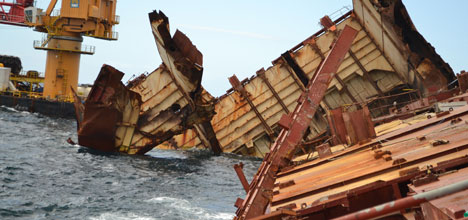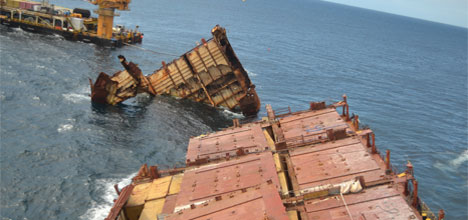Rena salvors are taking advantage of the calm weather conditions this week to remove the remaining oil from the submerged stern section of Rena.
The crane barge Smit Borneo is now reconnected to the starboard side of the mostly submerged stern section of the ship, which grounded on Astrolabe Reef on October 5 last year.
The wreck as viewed from the helipad, with the Smit Borneo in the background. Photo: LOC
On Thursday, Svitzer salvors removed an estimated 10tonnes of heavy fuel oil from the number 5 starboard tank. The exact amount of oil left in this tank is unknown, but it is estimated to be up to 30 tonnes.
Salvors are using the ‘hot tap' technique to remove oil, which allows recovery of polluting liquids without creating big spillages.
When a tank is hot tapped a number of valves are placed in strategic locations where fuel will collect, and can then be pumped or displaced through a pipe.
To place the valves a flange is attached to the outside of the tank by welding or adhesive.
The welded flange was the first way to do this which is where the 'hot” in hot tapping originated.
Once the flange or landing plate is attached, a valve with a cam lock hose fitting and piercing tip that will puncture the tank, is pressed or screwed into the flange.
When the valve is fully seated in the flange it creates tight seal and can be used as any other valve.
Adhesive flanges are used where flammable materials make welding too hazardous.
A hot-tap device can also drill through the plating through the open valve, which permits the saw to be withdrawn without allowing the tank's contents to escape.
A carbide-toothed hole saw is usually used but advances in hot-tapping technology mean waterjet cutting devices can be as an alternative.
A new generation of hot-tapping devices employs waterjets exerting pressures of up to 60,000 psi. Abrasive compounds can also be injected into the device to speed up cutting.
After the saw is backed out and the valve closed, a suction hose is fitted to the landing plates.
Water pressure is used to drive the lighter oil from the tank.
Owners of the Smit Borneo, Netherlands based Smit B.V. are the developers of a diver-less recovery system that is capable of removing pollutants from wrecks at great depths without the added cost and hazard of saturation diving.
 The wreck at deck level. Photo: LOC
The wreck at deck level. Photo: LOC
The system relies on a remotely operated hot-tapping device to drill the hole and install the valve.
Once the tank is tapped, the system uses a remotely operated offloading system to pump the contents to the recovery vessel.
The weather forecast for the weekend is for moderate winds, gusting up to 20 knots.
The Braemar Howells recovery team is also using divers to retrieve parts of two submerged containers from the seabed at the north end of Motiti Island.
The containers are lying in water about six metres deep. The divers are using air-driven cutters to reduce the containers into pieces so they can be winched onto a barge.
The team is also continuing maintenance work on Matakana Island picking up fresh debris that has washed ashore.
Beaches have been surveyed in preparation for the Easter public holiday with most are found to be clear of debris.
Waihi Beach is clear but gloves found buried in the sand are still being collected from the Bowentown area, while Shelly Bay and Anzac Bay at the Bowentown Heads appear to be debris free. Some container insulation foam is to being collected from Papamoa Beach.
Container numbers remain unchanged with a total of 573 retrieved from the wreck by Svitzer and 72 from the sea or shore by Braemar Howells, making a total of 645 accounted for onshore.
So far 21containers have been located on the sea bed away from Rena, but are yet to be recovered.
Shoreline clean up assessment teams are continuing to assess and reassess affected areas at regular intervals. A team working near Sulphur Point this week identified and picked up a small amount of oil, however in general, the teams have reported clear results following clean-up operations.
There is still residual oil in the sand which will from time to time be exposed – members of the public are encouraged to report any oil sightings to the oil spill response team on 0800 OIL SPILL.



0 comments
Leave a Comment
You must be logged in to make a comment.